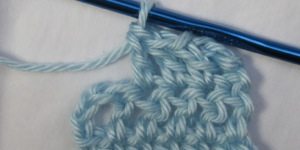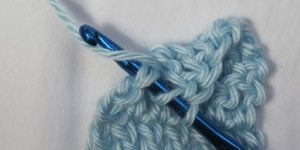^ Learn Crochet index page – Previous: Bigger and Smaller + Next: Choose Your Weapon
In this page: half double crochet, double crochet, turning chains, alternative approaches to the dc turning chain, a warning about the back of hdc, decreases, wave washcloth pattern, simplified star stitch for blankets, double quartet scarf pattern, patterns elsewhere.
In this section we reach a point where there is not quite consensus on the “correct” way to crochet. The fact that crochet isn’t rule-bound is actually one of the things I like about it, but it can make teaching and learning a bit confusing. I’ll start with the information as I learned it and as is standard to some sources (such as the Craft Yarn Council). After that I’ll teach the controversy.
Stitches are made taller in crochet by wrapping yarn around the hook before it enters the previous stitch. As usual, the yarn wraps back to front over the top of the hook. It’s a little fiddly to keep it in place at first so stick with it. We’ll cover two such stitches, half double crochet and double crochet; they begin the same way but half double crochet bears a few resemblances to single crochet than double crochet does not. Both begin with the following picture.
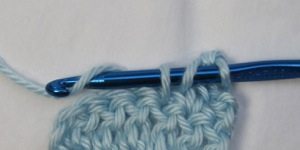
Half double crochet (hdc; called half treble crochet in UK terminology): YO, insert hook through stitch; YO, pull lp through stitch (3 lps on hk; top picture); YO, pull lp through all lps on hk (below).

Put your finger on the yarn spiraling around the hook or it will twist away from you. I often find it easiest to pull the last loop through the first two loops on the hook in one step, and then readjust my hook angle and pull it through the third loop in a separate motion. Crochet Spot has righty photos that turn lefty when you hover over them.
Double crochet (dc; called treble crochet in UK terminology): YO, insert hook through stitch; YO, pull lp through stitch (3 lps on hk; top picture); YO, pull lp through first 2 lps on hk (2 lps on hk; below left); YO, pull lp through both lps on hk (below right).
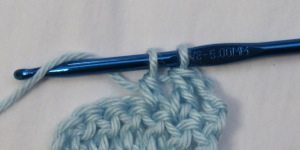
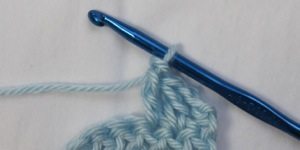
As for hdc, Crochet Spot has dc photos that turn from righty to lefty at your command.
Dc is a bit more than twice as tall as sc, and hdc is midway between. Since they are taller, they need more turning chains to start a row: 2 for hdc and 3 for dc. The picture below shows dc, hdc, sc, and sl st, left to right, which respectively need 3, 2, 1, and 0 turning chains.
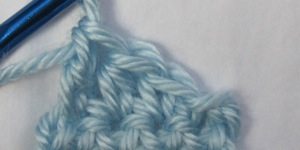
Something odd happens when we pass from hdc to dc, as well: the turning chain counts as a stitch. This has three practical consequences: first is that a starting chain will give the same number of stitches in either hdc or dc, despite them using a different number of turning chains. The 8-link chain below will make a row of 6 hdc or dc. For hdc, the first stitch will be in the 3rd chain from the hook (6th chain made originally), and the two chains in between will not count as a stitch. For dc, the first stitch will be made in the 4th chain from the hook (5th chain made originally), and the 3 chains in between will count as a stitch. Therefore, for both hdc and dc the number of chains you need to start with is the number of desired stitches plus 2.
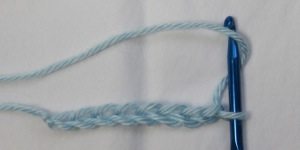
The second consequence is that you don’t stitch into the first dc of the previous row, instead skipping to the second one since your turning chain accounts for the first (pictured below). This is, of course, unless the first instruction of the row is dc inc, in which case you would make one dc into the first stitch, as the second stitch of the increase. The For Dummies site has a picture of this increase.
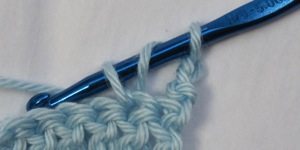
Third and trickiest, when you get to the end of the row you have to stitch into something that doesn’t look like the other things you stitched into. Now, the first row is still the hardest row, but the last stitch of each subsequent row is noticeably harder than the rest. My first swatch of double crochet was a trapezoid for this reason. The simplest solution is counting: if you don’t have enough, you still have something to stitch into. The first picture below shows a row with two dc left to complete it. The second picture shows insertion of the hook for the final dc.
When you go to stitch into the turning chain pick up two strands of it – if you pick up only one there will be a gap caused by the chain pulling out of shape, and if you pick up all three (i.e., stitch around the chain instead of into it) your stitch may not stay where it should. Either of methods 2 and 3 of stitching into the chain are fine.
The last half double crochet can be harder to identify than the last single crochet, as well, even though it is a stitch like all the others in the row. Vashti’s Crochet Pattern Companion has an extensive post about exactly that.
Now for the disagreements. Not everyone uses the same number of turning chains beyond single crochet; some continue with only 1 for hdc and use only 2 for dc. I have seen sources that count the turning chain for hdc as a stitch and sources that do not. Since I think the turning chain makes a poor substitute for a stitch, I prefer the method that does not count it. I have even seen one source that did not count the turning chain for dc as a stitch, but there is much more consensus that it does. However, most crocheters find it rather unsatisfactory since it is spindly and leaves a gap between itself and the first “real” dc stitch, and there are various ways to solve the problem. I explored a number of them and concluded either chaining 2 and not counting it as a dc, or making a faux dc with the chain left on the hook at the end of the previous row are my preferred methods.
Now that you have that down, let me give you some more external sources, which are varied in terms of what they tell you to do for turning chains and counting or not counting them as stitches.
Diagrams for half double crochet from For Dummies, righty video from Tamara Kelly, and lefty video from The Art of Crochet by Teresa.
Diagrams for double crochet from For Dummies, righty video from Tamara Kelly, and lefty video from the Crochet Guild of America. Tamara Kelly also has a video on double crochet that illustrates what happens when the turning chain is or is not counted as a stitch.
Be warned that hdc has a faux teardrop on the back, which will be the front on the following row. Careful to stitch into the correct two strands! One way to check this is that the points of the teardrops you are supposed to stitch into, when working in rows, will point in your direction of work (to the left for a right-hander, and vice-versa; this is true for all the stitches). The “teardrops” on the back of the hdc point the opposite direction, back where you have come from. The picture below left shows the faux teardrop, and the picture below right the correct one. If you are working in rounds without turning the work in between them, you won’t have to worry about the faux teardrop because you won’t see it.


NO YES
For decreases, perform all but the final yarn-over/pull-through in the first stitch of the two you are stitching together, and then repeat that in the next stitch, pulling the final loop of yarn through all the loops on the hook (3 for dc, 5 for hdc). In abbreviated form:
hdc dec (hdc2tog): YO, insert hk in next st. YO, pull lp through st (3 lps on hk). YO, insert hk in next st. YO, pull lp through st (5 lps on hk; first picture below). YO, pull lp through all 5 lps on hk (second picture below). There are photos from Crochet Spot for this, and as above they change from right handed to left handed on mouseover.
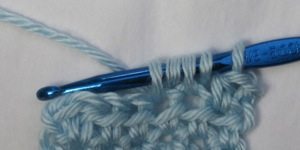

dc dec (dc2tog): YO, insert hk in next st. YO, pull lp through st (3 lps on hk). YO, pull lp through first 2 lps on hk (2 lps on hk). YO, insert hk in next st. YO, pull lp through st (4 lps on hk; first picture below). YO, pull lp through first 2 lps on hk (3 lps on hk; second picture below). YO, pull lp through all 3 lps on hk (third picture below). Here are diagrams from For Dummies and a video from Tamara Kelly; note the video also covers single crochet decrease.
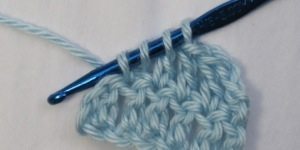
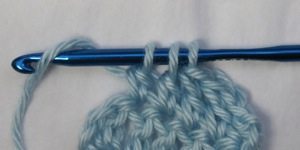

I find this hdc dec too bulky (five loops, really?) so I substitute my own, which omits the YO before the second stitch insertion:
Reve’s preferred hdc dec: YO, insert hk in next st. YO, pull lp through st (3 lps on hk). Insert hk in next st. YO, pull lp through st (4 lps on hk; first picture below). YO, pull lp through all 4 lps on hk (second picture below).
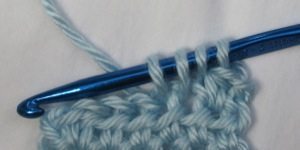
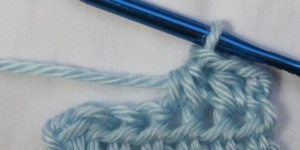
It is basically a partial hdc followed by a sc that is joined to it by the final loop, or alternatively, a sc dec with a YO inserted at the beginning. I’m not the only one who does it this way but the websites I found are unanimous in the standard decrease. Google Books tells me that Crochet Patterns for Dummies teaches this smaller decrease, though I can find no hdc decrease at all on the For Dummies website.
Practice:
Here’s a pattern that allows you simply to practice the taller stitches.
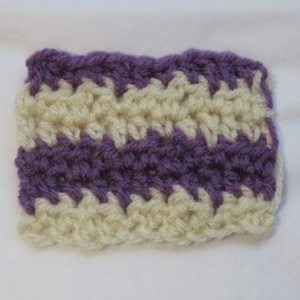 Wave Washcloth:
Wave Washcloth:
Ch a multiple of 4.
Starting in 2nd ch from hk: sc, hdc, dc, *hdc, sc, hdc, dc.* Repeat *…* to end.
All subsequent rows are made by chaining 1 and following the same pattern as above, starting with sc.
It is best to end on an even-numbered row. This can be striking if rows 1, 4, 5, 8, 9, … are one color, and 2, 3, 6, 7, 10, 11, … are another, alternating every two rows after the first (see the next section for color change). In this case if you end on a row number divisible by 4 you will begin and end with a single row of the same color.
An actual washcloth should be out of cotton yarn (as should anything with “getting wet” in its job description). With an H hook, chaining 28 and stitching 24 or 26 rows is a good size.
You could also make a scarf with a Q hook and bulky yarn, but I haven’t worked out the counts!
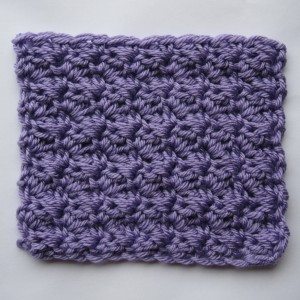 I recently mended an afghan with a simple but interesting-looking stitch pattern I have yet to find online. We have a new pattern convention for this one: […] or (…), which indicates the stitches enclosed should be made all in the same stitch of the previous row (or chain). Unfortunately you will often see these notations interchanged with the asterisk repeat notation. I stick to square brackets so parentheses are reserved for stitch counts and actual parenthetical notes. But back to the pattern – it’s a sort of simplified star stitch: chain any even number.
I recently mended an afghan with a simple but interesting-looking stitch pattern I have yet to find online. We have a new pattern convention for this one: […] or (…), which indicates the stitches enclosed should be made all in the same stitch of the previous row (or chain). Unfortunately you will often see these notations interchanged with the asterisk repeat notation. I stick to square brackets so parentheses are reserved for stitch counts and actual parenthetical notes. But back to the pattern – it’s a sort of simplified star stitch: chain any even number.
1. Starting in 2nd ch from hk, *[sc, dc] in next ch, sk 1 ch*. Repeat *…* until 1 ch is left; sc in last ch.
2-∞. Ch 1, turn. [Sc, dc] in each sc of prev row except last; sc in last sc. Sk every dc.
The picture to left was made with worsted weight yarn, a K hook (6.5mm), and a starting chain of 16 links. The pattern takes best to larger hooks; it fills the space nicely so it’s soft without being holey – a great blanket stitch.
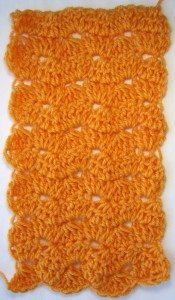 To left is a pattern I developed for double crochet increase and decrease that I call the double quartet scarf stitch. Decreases for dc and hdc are used primarily for shaping, not appearance, and it is difficult to find patterns that use them heavily (I have a book of crochet stitch patterns and zero of them use decreases for any stitch). To get a little more drama I’m using fourfold increases and decreases. Fourfold increase is simply four stitches in the same previous stitch. Fourfold decrease is an extension of the standard decrease.
To left is a pattern I developed for double crochet increase and decrease that I call the double quartet scarf stitch. Decreases for dc and hdc are used primarily for shaping, not appearance, and it is difficult to find patterns that use them heavily (I have a book of crochet stitch patterns and zero of them use decreases for any stitch). To get a little more drama I’m using fourfold increases and decreases. Fourfold increase is simply four stitches in the same previous stitch. Fourfold decrease is an extension of the standard decrease.
Double Crochet Four Together (dc4tog): *YO, pull up lp in next st; YO, pull through 2 lps on hk* four times (5 lps on hk). YO, pull through all 5 lps on hk.
Double Quartet Scarf Stitch: Ch any multiple of 5, plus 3 for turning ch (sample starts with 18).
1. Make 3 dc all in 4th ch from hk. *Dc4tog, 4 dc in next ch* until 4 chs remain; dc4tog.
2-∞. Ch 3; 3 dc in first st. *Dc4tog, 4 dc in next st* until 3 dc and turning ch remain; dc4tog.
Continue to desired length. Ch 1 at end of last row and finish off yarn.
Tips: This pattern is best when the hook is quite large for the yarn – the sample was made with an N hook (9mm) and worsted weight yarn. The first row will distort the chain; to make sure you don’t skip a chain after an increase, pull the ends of the chain apart from each other. In subsequent rows note the increases will all be in loops that sit on top of a stack of four more loops (the results of the dc4tog). The pattern will look like nothing for a couple of rows and will look its best if pulled vertically (first and last rows pulled apart from each other).
Patterns elsewhere:
This coffee cup cozy is stitched flat with sc, hdc, and dc, and sewn into a tube.
With double crochet and some innovative turning you can make crocheted ric-rac. Note when she says “chain” with no number she means to chain 1.
Hdc is a good stitch for fingerless gloves, nice and dense. Try making fingerless gloves with hdc instead of sc. Dc is a nice scarf stitch. Right now it might be a little dull to make a scarf, but after learning to change colors you can make a striped one.
Here is a practical and lovely pattern with which to practice hdc and its decrease: Tower of Babel hook stand.
A small flower made with double crochet is at Aesthetic Nest; this also has a slightly larger flower made with triple crochet, which you are well equipped to learn.
For additional increase and decrease practice, try making the zig-zag bracelet in hdc or dc. You’ll need fewer repetitions of the pattern to fit. In dc you’ll have to omit the one-stitch row or replace it and the next row with “ch 6, dc in 4th ch from hk”, and the first increase in a row will be achieved by making one dc in the first stitch (typically accounted for by the turning chain alone).
^ Learn Crochet index page – Previous: Bigger and Smaller + Next: Choose Your Weapon
